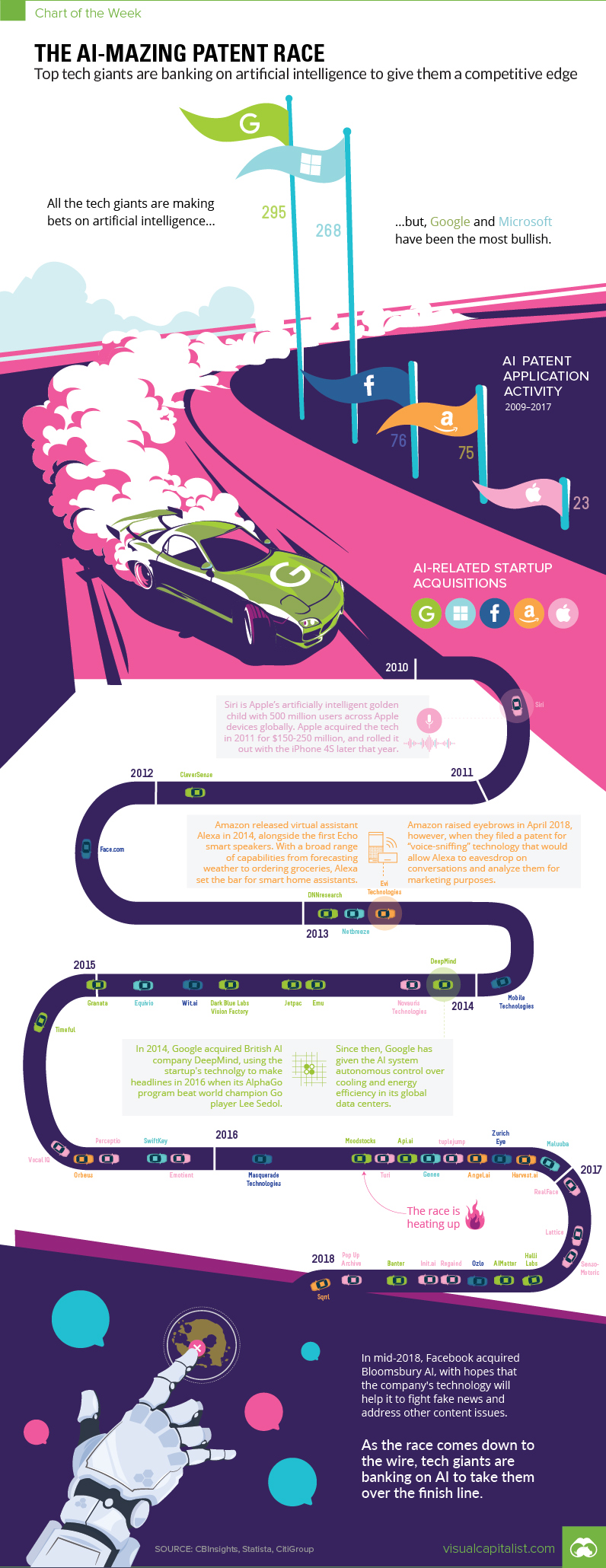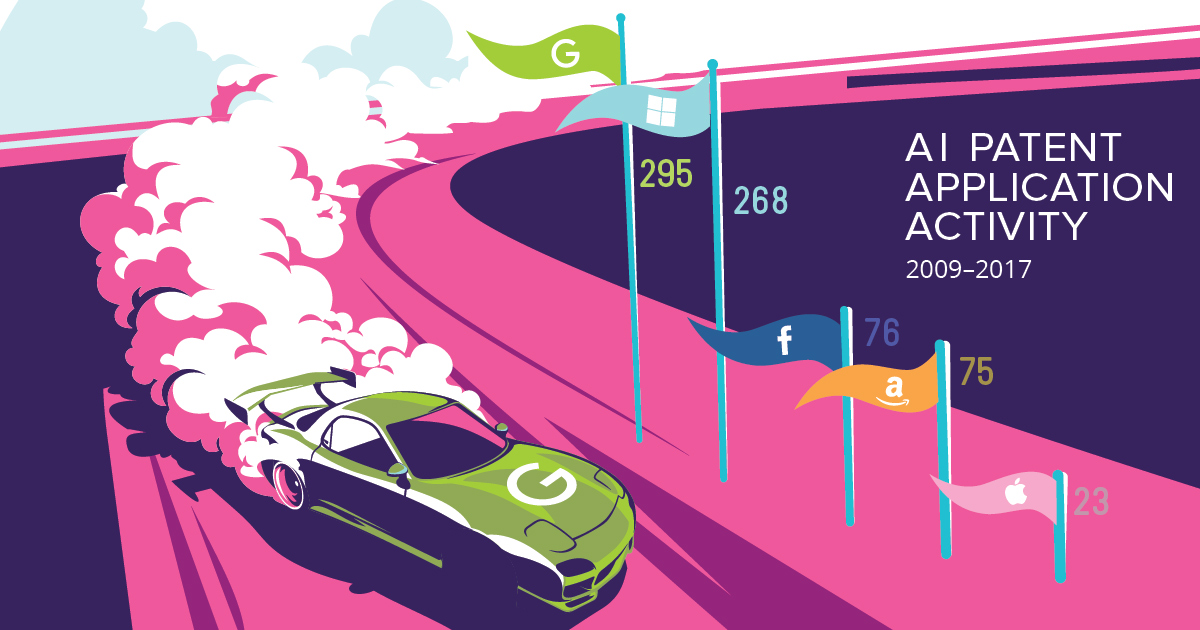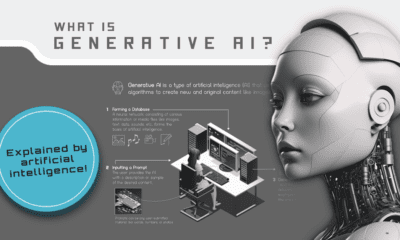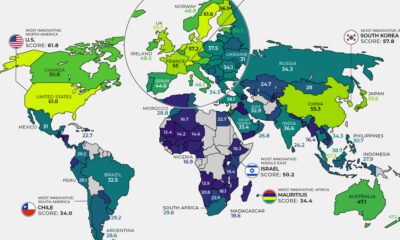Chart: The AI-mazing Patent Race
The Chart of the Week is a weekly Visual Capitalist feature on Fridays. Artificial Intelligence is transforming the way we live, and the tech giants are racing to stay ahead of the curve. AI-related funding totaled an estimated $15.2 billion in 2017, a 144% increase over the previous year. The U.S. tech industry leads with a 50% share of those investments, even with China swiftly closing the gap in terms of patents and AI research. AI itself isn’t new, but boosted computing power, increased connectivity, and the sheer volume of data has paved the way for the fourth industrial revolution of AI. “The coming era will be looked back upon as the ‘AI era,’ when AI became the defining competitive advantage for corporations, government agencies, and investment professionals,” predicts David Nadler, founder of Kensho Technologies.
The Potential of AI
Artificial Intelligence is less about sentience and more about accelerated learning. AI technology looks for patterns, learns from experience, and predicts responses based on historical data. An AI-powered computer can’t produce a unique thought, but it can probably predict yours. The end result: AI is able to learn new things at such a speed that it can predict your behavior and preempt your requests. From the advancements in natural language processing that make Siri and Alexa possible, to the machine learning advancements that give robo-advisors their trading chops, AI’s ability to simulate human thinking means it can also streamline our lives. It can preempt our needs and requests, making products and services more user friendly as machines learn our needs and figure out how to serve us better. This makes AI a vital source of competitive advantage.
AI’s Competitive Advantage
In their quest to stay on top of the Silicon Valley food chain, familiar tech and retail giants are dipping their toes in AI to execute diverse strategies: Google Google uses machine learning and pattern recognition in its search and facial recognition services, as well as natural language processing for real-time language translation. The company has also released a series of smart home products, like the Nest thermostat. After acquiring more than 50 AI startups in 2015-16, this seems like only the beginning for Google’s AI upgrade. Microsoft Microsoft’s Cortana is powered by machine learning, allowing the virtual assistant to build insight and expertise over time. In 2016, the tech giant added Research and AI as their fourth silo alongside Office, Windows, and Cloud, with the stated goal of making broad-spectrum AI application more accessible and everyday machines more intelligent. Apple Apple is notoriously tight-lipped about their AI research, but it’s safe to say Siri is only the tip of the iceberg. The tech giant received a patent this year for augmented-reality glasses, slated for a release in 2020. Facebook Facebook uses artificial intelligence to suggest photo tags, populate your newsfeed, and detect bots and fake users. The social media giant has also come under fire for their widespread use of AI analytics to target users for marketing and messaging purposes. These tech kings are driving the research that will increasingly intertwine our lives with artificial intelligence, and it’s that investment that just might secure their future. on But fast forward to the end of last week, and SVB was shuttered by regulators after a panic-induced bank run. So, how exactly did this happen? We dig in below.
Road to a Bank Run
SVB and its customers generally thrived during the low interest rate era, but as rates rose, SVB found itself more exposed to risk than a typical bank. Even so, at the end of 2022, the bank’s balance sheet showed no cause for alarm.
As well, the bank was viewed positively in a number of places. Most Wall Street analyst ratings were overwhelmingly positive on the bank’s stock, and Forbes had just added the bank to its Financial All-Stars list. Outward signs of trouble emerged on Wednesday, March 8th, when SVB surprised investors with news that the bank needed to raise more than $2 billion to shore up its balance sheet. The reaction from prominent venture capitalists was not positive, with Coatue Management, Union Square Ventures, and Peter Thiel’s Founders Fund moving to limit exposure to the 40-year-old bank. The influence of these firms is believed to have added fuel to the fire, and a bank run ensued. Also influencing decision making was the fact that SVB had the highest percentage of uninsured domestic deposits of all big banks. These totaled nearly $152 billion, or about 97% of all deposits. By the end of the day, customers had tried to withdraw $42 billion in deposits.
What Triggered the SVB Collapse?
While the collapse of SVB took place over the course of 44 hours, its roots trace back to the early pandemic years. In 2021, U.S. venture capital-backed companies raised a record $330 billion—double the amount seen in 2020. At the time, interest rates were at rock-bottom levels to help buoy the economy. Matt Levine sums up the situation well: “When interest rates are low everywhere, a dollar in 20 years is about as good as a dollar today, so a startup whose business model is “we will lose money for a decade building artificial intelligence, and then rake in lots of money in the far future” sounds pretty good. When interest rates are higher, a dollar today is better than a dollar tomorrow, so investors want cash flows. When interest rates were low for a long time, and suddenly become high, all the money that was rushing to your customers is suddenly cut off.” Source: Pitchbook Why is this important? During this time, SVB received billions of dollars from these venture-backed clients. In one year alone, their deposits increased 100%. They took these funds and invested them in longer-term bonds. As a result, this created a dangerous trap as the company expected rates would remain low. During this time, SVB invested in bonds at the top of the market. As interest rates rose higher and bond prices declined, SVB started taking major losses on their long-term bond holdings.
Losses Fueling a Liquidity Crunch
When SVB reported its fourth quarter results in early 2023, Moody’s Investor Service, a credit rating agency took notice. In early March, it said that SVB was at high risk for a downgrade due to its significant unrealized losses. In response, SVB looked to sell $2 billion of its investments at a loss to help boost liquidity for its struggling balance sheet. Soon, more hedge funds and venture investors realized SVB could be on thin ice. Depositors withdrew funds in droves, spurring a liquidity squeeze and prompting California regulators and the FDIC to step in and shut down the bank.
What Happens Now?
While much of SVB’s activity was focused on the tech sector, the bank’s shocking collapse has rattled a financial sector that is already on edge.
The four biggest U.S. banks lost a combined $52 billion the day before the SVB collapse. On Friday, other banking stocks saw double-digit drops, including Signature Bank (-23%), First Republic (-15%), and Silvergate Capital (-11%).
Source: Morningstar Direct. *Represents March 9 data, trading halted on March 10.
When the dust settles, it’s hard to predict the ripple effects that will emerge from this dramatic event. For investors, the Secretary of the Treasury Janet Yellen announced confidence in the banking system remaining resilient, noting that regulators have the proper tools in response to the issue.
But others have seen trouble brewing as far back as 2020 (or earlier) when commercial banking assets were skyrocketing and banks were buying bonds when rates were low.

















